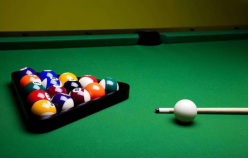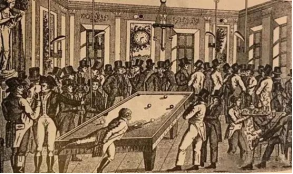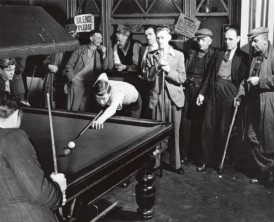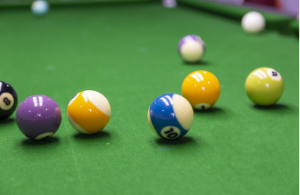Billiards, a sport that showcases wisdom and skills on the green felt surface, has become popular worldwide with its unique charm. It has a long history and profound cultural heritage, continuously developing and evolving over the long course of time, attracting generation after generation of enthusiasts to engage in it.

Regarding the origin of billiards, although there are various opinions, it is generally believed that it was born in Western Europe. There is an interesting theory that billiards quietly emerged during the reign of King Charles VII of France. In 1510, billiards officially made its appearance in France. King Louis XIV was very fond of it, and his royal physician even recommended that the king play billiards after meals to promote physical health. This recommendation led to the rapid popularity of billiards in the French court in the 17th century, making it a popular choice for the nobility’s entertainment. At that time, billiards exuded the elegance of an aristocratic sport. The equipment was luxurious, and the rules were cumbersome, and it was only enjoyed by a small number of the privileged class.
Early billiards were quite different from modern ones in terms of both equipment and playing methods. The balls were initially made of brass and wood. Later, in pursuit of better performance, they were made of ivory. However, on average, only 5 balls could be made from one piece of ivory, and the high cost undoubtedly raised the threshold of the billiards sport extremely high, making it an exclusive entertainment for the royal family and the wealthy. The billiard tables at that time were also rather simple. At first, there was only a round hole in the center of the table, and later, holes were gradually added at the four corners, which was the embryonic form of the modern pocket billiard table.

As time passed, billiards equipment underwent a series of innovations. In 1827, the wooden tabletop was upgraded to a stone tabletop, and subsequently, the wooden table edges were replaced by rubber table edges, which greatly improved the performance of the table, making the balls roll more smoothly and stably. In 1868, Hyatt developed plastic billiard balls. This invention was like a powerful bomb, triggering a revolutionary change in the billiard manufacturing industry, making the production of billiard balls more efficient and reducing the cost significantly, laying a material foundation for the popularization of billiards. In the early 19th century, the invention of the cue tip and the appearance of chalk also played a crucial role in promoting the development of the billiards sport. The cue tip increased the friction between the cue and the ball, allowing players to control the hitting force and direction more accurately; chalk effectively prevented the cue from slipping when hitting the ball, greatly improving the stability of hitting.

In terms of the improvement of rules, 1875 was an important milestone. British officers and soldiers stationed in India, on the basis of the original English billiards, creatively added multiple colored balls and invented snooker. In 1880, after snooker was brought back to the UK, the official competition rules were introduced. In 1885, the Billiards Association of the UK was established, and the first set of formal competition rules was formulated, providing a strong guarantee for the standardized development of the billiards sport. In 1919, the Billiards Association and the Billiards Management Club merged to form the Billiards Federation, which further improved the competition rules of English billiards and snooker, promoting the billiards sport to move towards a more professional and orderly direction.
At the same time, different billiards styles gradually took shape. After 1800, the billiards sport crossed the ocean, took root in the United States, and quickly became popular. With their innovative spirit, Americans boldly improved and perfected the techniques, competition methods, and rules of billiards, creating the unique American billiards style. American billiards, with its simple and clear rules and fast and intense rhythm, stands alongside French billiards and English billiards, jointly enriching the big family of the billiards sport.
In the 19th century, billiards enjoyed its first boom.。In the UK and the US, billiards became a favorite pastime of the upper class and frequently appeared in literary and artistic works, further consolidating its cultural status. Entering the 20th century, after experiencing large-scale popularization, the billiards sport faced fierce competition and challenges from other sports and entertainment programs. However, televised billiards competitions were like a timely rain, playing a crucial role in maintaining its public attention, enabling billiards to still occupy an important place on the sports stage. In the late 20th century, the billiards sport even embarked on a global dissemination journey. Asian countries such as China and India warmly embraced this sport. These countries not only cultivated many excellent players but also actively held various international competitions, injecting strong impetus into the global promotion of the billiards sport. Nowadays, billiards has developed a rich variety of playing methods. From traditional French billiards and English billiards to dynamic American billiards, challenging snooker, and unique Chinese billiards, etc., it meets the needs of different regions and different groups of people. The professional competition system has also become increasingly improved. Many top-level competitions such as the World Billiards Championship and the events of the Professional Billiards Association of the US provide a stage for professional players to showcase their exquisite skills and intense competition. Various professional organizations such as the World Billiards Federation, the World Professional Billiards and Snooker Association, and the World American Billiards Association play an indispensable role in coordinating competitions, formulating rules, and promoting the billiards sport. Spike Billiard Table has a production history of 23 years in the billiards industry. The Chinese 8-ball, American 9-ball, and English snooker tables it produces meet international standards, achieve a competition-level playing feel, and are sold both at home and abroad. There are up to tens of thousands of offline billiards clubs. Its high-quality tables and attentive services have won unanimous praise from customers.

Billiards is not just a sport but also a vivid history textbook, carrying human wisdom and creativity. It is a unique cultural symbol that crosses time, national boundaries, and social classes, closely connecting people and enabling them to enjoy the endless fun and challenges brought by this sport together. In the days to come, it is believed that the billiards sport will continue to shine brightly and write an even more glorious chapter.
